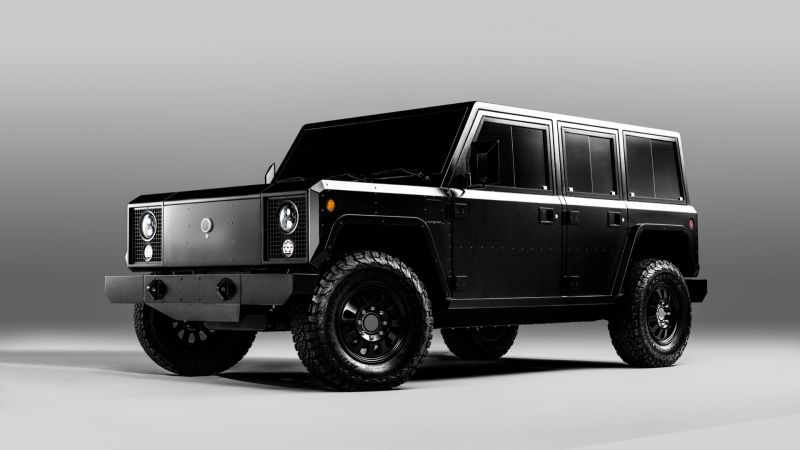
author: Eric Walz
The rugged Bollinger Motors B1 sport-utility truck was unveiled in Sept 2019.
Electric truck startup Bollinger Motors, which was targeting the truck and SUV market with its rugged and utilitarian vehicles, announced that its will postpone its entry into the electric passenger vehicle market and focus on building electric trucks for commercial purposes instead.
Bollinger Motors, which was founded in 2015, said it will manufacture all-electric platforms and chassis cabs for commercial vehicles in Classes 3-6.
The news was announced today via video on Bollinger’s Instagram and YouTube.
The company planned to sell two rugged electric trucks, the B1 sport-utility truck and B2 pickup, which were unveiled in Sept 2019. Like rival Rivian, Bollinger was targeting the outdoor adventure passenger vehicle market with its two trucks. They were marketed as “sport utility trucks” more closely resembling a Jeep Wrangler or Land Rover Defender.
“We started Bollinger Motors in 2015 with a dream and a desire to make the best trucks possible,” said Robert Bollinger, CEO of Bollinger Motors. “We’ve put countless hours of hard work and passion into making something that makes us proud. However, today, we’re postponing the consumer trucks’ development and shifting our focus to commercial trucks and fleets.”
The company’s B2 electric pickup was rated at 614 horsepower with 668 ft-lb torque. The 4-door B1 sport-utility truck has a shorter wheelbase, while the B2 is essentially the same as the B1 with a 20 inch longer wheelbase and extended cargo area.
In 2020, Bollinger announced it was awarded a U.S. patent for its radical new passthrough and “frunkgate” design with a front grill that opens like a conventional pickup truck tailgate in the B1 and B2 trucks. The “Frunkgate” refers to the fold-down portion in the front of the truck, similar to a pickup truck’s rear tailgate.
The patented passthrough runs from the back of the truck to the front uninterrupted, creating a long, open cargo space that measures 16 feet long when the tailgate and “frunkgate” are closed. When both gates are open, the passthrough channel can fit cargo nearly 20 feet long, such as lumber, ladders or pipes. It’s large enough to fit up to 40 pieces of 2×4 cut lumber.

The patented passthrough runs from the back of the truck to the front uninterrupted.
Bollinger’s Commercial “E-Chassis” EV Platform
Bollinger’s transition to building commercial electric vehicles won’t start from scratch. The Bollinger B1 and B2 sit on a Class-3 electric chassis that the company calls an “E-Chassis.” It can accommodate a wide variety of truck bodies, so its versatile enough for Bollinger to expand its model lineup for the commercial market.
It was the world’s first and only Class-3 electric vehicle platform, according to Bollinger.
Class-3 trucks are designated as “medium trucks” and weigh between 10,001-14,000 lbs. Examples of Class-3 trucks are the Ford F-450 pickup and GMC Sierra 3500.
“When we first built our Class 3 B1, we knew there was a commercial aspect to the platform,” said Robert Bollinger in 2020. “Not only cab-on-chassis, but entirely new truck bodies can fit on our E-Chassis, and help propel the world to all-electric that much faster.”
In 2020, Bollinger Motors said its E-Chassis would include a standard 120 kWh battery pack and features dual motors, all-wheel drive, all-terrain capabilities, as well as a 5,000-lb payload capacity.

Bollinger’s electric truck platform.
Bollinger’s E-Chassis also features Portal gear lifts, which are normally found on rugged off road vehicles or military vehicles.
The Portal gear hub is a set of gears mounted at the end of the axle that connects the axle to drive the wheel hub. It allows the axle to be placed higher in the chassis and the wheel hub can be mounted below the axle’s center line. The setup increases ground clearance as the axle can be positioned higher above the wheels.
Even though the axles are higher than a conventional 4×4 setup, the position of the batteries in the E-Chassis still gives the platform a very low center of gravity. However the fully customizable E-Chassis can be configured for a variety of uses with or without the portal gear hubs. However, it’s not clear if Bollinger will implement the Portal gear design for its commercial lineup of trucks.
Bollinger’s E-Chassis also features standard safety systems such as ABS brakes, electronic traction and stability control, hydraulic power steering, hydro-pneumatic self-leveling suspension, an independent suspension and a 5-15 kw on-board charger/inverter for power tools or other accessories.

Bollinger’s Class 3-6 electric truck platform is versatile.
Bollinger will refund deposits for those who’d previously reserved the electric B1 sport utility truck and the B2 pickup truck. Some of these customers will be disappointed, since Bollinger two passenger electric trucks were unique, as well as rugged.
In Aug 2020, Bollinger unveiled its DELIVER-E all-electric delivery van concept, which is well suited for the delivery market. Its similar to the electric delivery vans that Rivian is supplying to Amazon.
The front-wheel drive, all-electric DELIVER-E platform was engineered to fit Classes 2B, 3, 4, and 5. Bollinger said last year that a wide selection of battery packs will be available for the DELIVER-E, including 70, 105, 140, 175, and 210 kWh.
Going forward, Bollinger Motors said that it will continue to grow and develop technology “that will have a major impact in the automotive world’s green future.”
